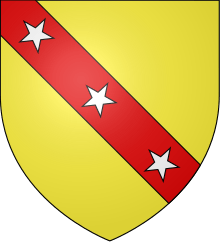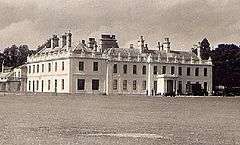Richard Bampfylde
Sir Richard Warwick Bampfylde, 4th Baronet (21 November 1722 – 15 July 1776)[1] of Poltimore, North Molton, Warleigh, Tamerton Foliot and Copplestone in Devon and of Hardington in Somerset,[2] England, was Member of Parliament for Exeter (1743–47) and for Devonshire (1747–76).

Origins

He was the only son and heir of Sir Coplestone Bampfylde, 3rd Baronet of Poltimore, North Molton and Warleigh in Devon and of Hardington in Somerset, by his wife Gertrude Carew, daughter of Sir John Carew, 3rd Baronet,[3] of Antony in Cornwall. He was baptised in Poltimore in Devon.[4]
Career
In 1727, aged only five, he succeeded his father as 4th baronet.[5] He was educated at New College, Oxford and graduated as Master of Arts in 1741.[4] He was Member of Parliament for Exeter from 1743 to 1747[6] and subsequently for Devonshire from 1747 until his death in 1776.[7] He was Lieutenant-Colonel of the East Devon Militia from its formation in 1758 until he resigned in 1771.[8]
Marriage and progeny
On 8 August 1742 in the chapel of Somerset House,[4] London, he married Jane Codrington (d.1789), daughter and heiress of Colonel John Codrington of Charlton House,[9] Wraxall, Somerset,[10] by whom he had six sons and seven daughters including:[11]
- Charles Warwick Bampfylde (1751–1751), eldest son who died an infant, buried at Poltimore.
- Sir Charles Bampfylde, 5th Baronet (1753–1823), MP, 2nd and eldest surviving son and heir.
- John Codrington Bampfylde (1754–1797),[12] 3rd son, the poet.[5]
- Amias Warwick Bampfylde (1757–1834), 4th son.[12]
- Richard Warwick Bampfylde (1769–1834), 5th son, appointed by his father Rector of Poltimore also Rector of Black Torrington, Devon.[12]
- Charlotte Bampfylde (born 1750), 5th daughter, wife of Abel Moysey (1743–1831) of Hinton Charterhouse, Somerset, MP for Bath (1774–1790).[13]
- Harriet, who married George Daniell, a physician, and was mother to George Daniell (medical doctor)
Landholdings
In 1741 his seats were Copplestone and Poltimore in Devon and Hardington in Somerset.[2] His townhouse in Exeter was Bampfield House, demolished in World War II.[14]
Death, burial & succession
Bampfylde died on 15 July 1776 and was buried at Poltimore. He was succeeded in the baronetcy by his eldest surviving son Sir Charles Bampfylde, 5th Baronet (1753–1823) .[11]
Further reading
- History of Parliament biography of Bampfylde, Sir Richard Warwick, 4th Bt. (1722–76), of Poltimore, Devon
References
- "Leigh Rayment - Baronetage". Retrieved 5 April 2009.
- Wotton, Thomas, The English Baronetage, Vol 2, London, 1741, p.195, Bampfylde of Poltimore
- Burke, John (1832). A Genealogical and Heraldic History of the Peerage and Baronetage of the British Empire. vol. I (4th ed.). London: Henry Colburn and Richard Bentley. p. 306.
- "ThePeerage - Sir Richard Bamfylde, 4th Bt". Retrieved 5 February 2007.
- Debrett, John (1824). Debrett's Baronetage of England. vol. I (5th ed.). London: G. Woodfall. p. 140.
- "Leigh Rayment - British House of Commons, Exeter". Retrieved 5 April 2009.
- "Leigh Rayment - British House of Commons, Devonshire". Retrieved 5 April 2009.
- Col Henry Walrond, Historical Records of the 1st Devon Militia (4th Battalion The Devonshire Regiment), With a Notice of the 2nd and North Devon Militia Regiments, London: Longmans, 1897/Andesite Press, 2015, ISBN 978-1-37617881-4, Appendix A, p. 410.
- History of Parliament biography
- Vivian, Lt.Col. J.L., (Ed.) The Visitations of the County of Devon: Comprising the Heralds' Visitations of 1531, 1564 & 1620, Exeter, 1895, p.40
- Kimber, Edward (1771). Richard Johnson (ed.). The Baronetage of England: Containing a Genealogical and Historical Account of All the English Baronets. vol. I. London: Thomas Wotton. p. 381.
- Vivian, p.41
- Vivian, p.41; History of Parliament biography of Moysey, Abel (1743–1831), of Hinton Charterhouse, Somerset
- Several of his children were born at Bampfield House (Vivian, p.41)
External links
| Parliament of Great Britain | ||
|---|---|---|
| Preceded by Humphrey Sydenham Sir Henry Northcote |
Member of Parliament for Exeter 1743–1747 With: Humphrey Sydenham |
Succeeded by Humphrey Sydenham John Tuckfield |
| Preceded by Sir Thomas Dyke-Acland, Bt Sir William Courtenay, Bt |
Member of Parliament for Devonshire 1747–1776 With: Sir William Courtenay, Bt 1747–1762 John Parker 1762–1776 |
Succeeded by John Rolle Walter John Parker |
| Baronetage of England | ||
| Preceded by Coplestone Bampfylde |
Baronet (of Poltimore) 1727–1776 |
Succeeded by Charles Bampfylde |